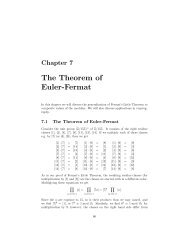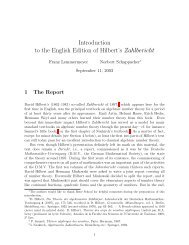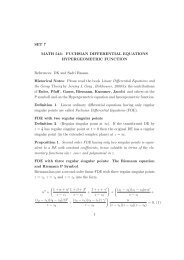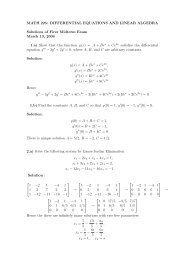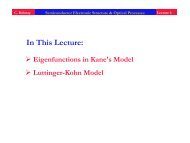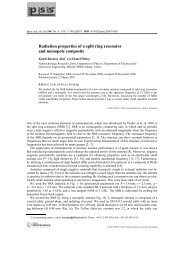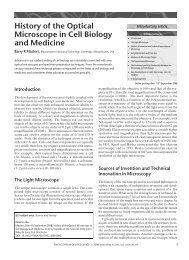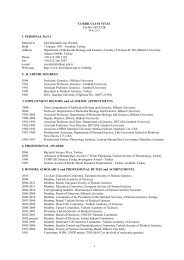Correlation of histology and linear and nonlinear microscopy of the ...
Correlation of histology and linear and nonlinear microscopy of the ...
Correlation of histology and linear and nonlinear microscopy of the ...
You also want an ePaper? Increase the reach of your titles
YUMPU automatically turns print PDFs into web optimized ePapers that Google loves.
Journal <strong>of</strong><br />
BIOPHOTONICS<br />
130<br />
B. R. Masters: <strong>Correlation</strong> <strong>of</strong> <strong>histology</strong> <strong>and</strong> <strong>linear</strong> <strong>and</strong> non<strong>linear</strong> <strong>microscopy</strong> <strong>of</strong> <strong>the</strong> living human cornea<br />
with confocal <strong>microscopy</strong> <strong>of</strong> <strong>the</strong> in vivo human cornea.<br />
It is important to emphasize <strong>the</strong> comparison <strong>of</strong><br />
in vivo confocal images <strong>of</strong> <strong>the</strong> human cornea <strong>and</strong><br />
histological studies <strong>of</strong> ex vivo human corneas in order<br />
to minimize errors <strong>of</strong> interpretation <strong>of</strong> <strong>the</strong> clinical<br />
images. At <strong>the</strong> same time, investigators should be<br />
aware <strong>of</strong> <strong>the</strong> morphological differences between in<br />
vivo <strong>and</strong> ex vivo corneas, as well as <strong>the</strong> fixation <strong>and</strong><br />
<strong>the</strong> staining artifacts <strong>of</strong> classical <strong>histology</strong>.<br />
2.2 Long-term effects <strong>of</strong> contact lens wear<br />
on <strong>the</strong> human cornea: a new corneal<br />
degeneration<br />
This paper illustrates <strong>the</strong> confounding effect <strong>of</strong> acquiring<br />
clinical confocal images <strong>of</strong> <strong>the</strong> human cornea<br />
with inappropriate optical resolution [18]. We posed<br />
<strong>the</strong> following question: what are <strong>the</strong> long-term effects<br />
<strong>of</strong> contact lens wear on <strong>the</strong> human cornea? We<br />
answered this question by first acquiring confocal<br />
images through <strong>the</strong> full thickness <strong>of</strong> <strong>the</strong> in vivo human<br />
cornea, <strong>and</strong> <strong>the</strong>n by a frame by frame analysis<br />
to determine morphological changes within <strong>the</strong> cornea<br />
that are correlated with long-term contact lens<br />
wear, <strong>and</strong> do not occur in subjects that do not wear<br />
contact lenses.<br />
The scanning-slit confocal microscope with a<br />
50X/1.0 NA water immersion objective was used to<br />
investigate <strong>the</strong> corneal morphology in long-term<br />
contact lens wearers [18]. The authors investigated<br />
13 patients with a history <strong>of</strong> up to 26 years <strong>of</strong> s<strong>of</strong>t<br />
contact lens wear, 11 patients with a history <strong>of</strong> up to<br />
25 years <strong>of</strong> rigid gas permeable contact lens wear,<br />
<strong>and</strong> a control group <strong>of</strong> 29 normal subjects without a<br />
history <strong>of</strong> contact lens wear. For contact lens wearers<br />
epi<strong>the</strong>lial microcystic changes <strong>and</strong> alterations <strong>of</strong> endo<strong>the</strong>lial<br />
cell morphology were found as described<br />
previously. The significant new finding was <strong>the</strong>re<br />
were highly reflective panstromal microdot (submicron)<br />
deposits in <strong>the</strong> entire thickness <strong>of</strong> <strong>the</strong> stroma<br />
for <strong>the</strong> contact lens wearers. It was concluded that<br />
this newly observed stromal microdot degeneration<br />
scales with <strong>the</strong> years <strong>of</strong> contact lens wear <strong>and</strong> may<br />
be <strong>the</strong> early stage <strong>of</strong> a significant corneal disease.<br />
Fur<strong>the</strong>r correlative microscopic studies involved<br />
electron <strong>microscopy</strong> <strong>of</strong> ex vivo human corneas, <strong>and</strong><br />
spectroscopic studies <strong>of</strong> <strong>the</strong> microdots.<br />
Initially, o<strong>the</strong>r groups were not able to observe<br />
<strong>the</strong> stromal microdot deposits because <strong>the</strong>y used a<br />
Nipkow disk confocal microscope with a low magnification<br />
(20X) <strong>and</strong> a low NA microscope objective<br />
(0.5). The low magnification, low NA microscope objective<br />
did not provide <strong>the</strong> necessary resolution to<br />
image <strong>the</strong> stromal microdot deposits. Alternatively,<br />
<strong>the</strong> Nipkow disk t<strong>and</strong>em-scanning confocal micro-<br />
scope did not provide sufficient illumination to image<br />
<strong>the</strong> submicron stromal microdot deposits in <strong>the</strong><br />
cornea.<br />
This study illustrates <strong>the</strong> requirement <strong>of</strong> <strong>the</strong> appropriate<br />
optical resolution in studies with <strong>the</strong> clinical<br />
confocal microscope, as well as correlative electron<br />
<strong>microscopy</strong> to validate <strong>the</strong> clinical conclusions.<br />
2.3 Overnight lid closure <strong>and</strong> <strong>the</strong> reversible<br />
micro-folds in <strong>the</strong> stroma <strong>of</strong> <strong>the</strong> human<br />
cornea<br />
The next study shows <strong>the</strong> importance <strong>of</strong> correct experimental<br />
protocol to investigate transient phenomena<br />
in <strong>the</strong> in vivo human cornea. This case report<br />
illustrates <strong>the</strong> use <strong>of</strong> <strong>linear</strong> confocal <strong>microscopy</strong><br />
(back scattered <strong>and</strong> reflected incoherent light) toge<strong>the</strong>r<br />
with optical low-coherence reflectometry<br />
(OLCR) to study <strong>the</strong> physiological question: does<br />
overnight lid closure affect <strong>the</strong> structure <strong>of</strong> <strong>the</strong> cornea<br />
stroma?<br />
This is an example <strong>of</strong> correlative studies involves<br />
a case report on <strong>the</strong> investigation <strong>of</strong> overnight lid<br />
closure <strong>and</strong> <strong>the</strong> reversible micro-folds in <strong>the</strong> stroma<br />
<strong>of</strong> <strong>the</strong> human cornea. We used clinical confocal <strong>microscopy</strong><br />
<strong>and</strong> parallel reversible changes in corneal<br />
thickness as measured with optical low-coherence reflectometry<br />
(OLCR) to validate <strong>the</strong> interpretation <strong>of</strong><br />
<strong>the</strong> confocal images <strong>of</strong> reversible micro-folds in <strong>the</strong><br />
human cornea stroma.<br />
The cornea is a specialized tissue, which maintains<br />
its normal optical properties from <strong>the</strong> fluid control<br />
exerted by <strong>the</strong> endo<strong>the</strong>lial pumping function in<br />
<strong>the</strong> presence <strong>of</strong> an intact epi<strong>the</strong>lial barrier. Failure <strong>of</strong><br />
ei<strong>the</strong>r one <strong>of</strong> <strong>the</strong>se results in corneal fluid accumulation,<br />
which can be observed with <strong>the</strong> slit lamp as<br />
corneal haze <strong>and</strong> possibly epi<strong>the</strong>lial edema. A large<br />
increase <strong>of</strong> corneal thickness may lead to <strong>the</strong> appearance<br />
<strong>of</strong> corneal folds, which can be easily visualized<br />
with <strong>the</strong> slit lamp. These folds are reversible <strong>and</strong><br />
may disappear if corneal hydration control has been<br />
re-established [19].<br />
On a daily basis <strong>the</strong> normal human cornea is subjected<br />
to hypoxic conditions under <strong>the</strong> closed lid during<br />
sleep [20–21]. It is well known that overnight lid<br />
closure results in a reversible, transient, increase <strong>of</strong><br />
central corneal thickness. A diurnal variation in corneal<br />
sensitivity <strong>and</strong> thickness was studied; <strong>the</strong> overnight<br />
mean corneal swelling was 2.9 percent, <strong>and</strong><br />
after two hours <strong>of</strong> open eye conditions with normal<br />
blinking, <strong>the</strong> cornea had deswelled to <strong>the</strong> same<br />
thickness as <strong>the</strong> previous night [22]. Ano<strong>the</strong>r study<br />
<strong>of</strong> diurnal variations in human corneal thickness<br />
found a mean overnight increase <strong>of</strong> central corneal<br />
thickness to be 5.5 percent [23].<br />
# 2009 by WILEY-VCH Verlag GmbH & Co. KGaA, Weinheim www.biophotonics-journal.org



